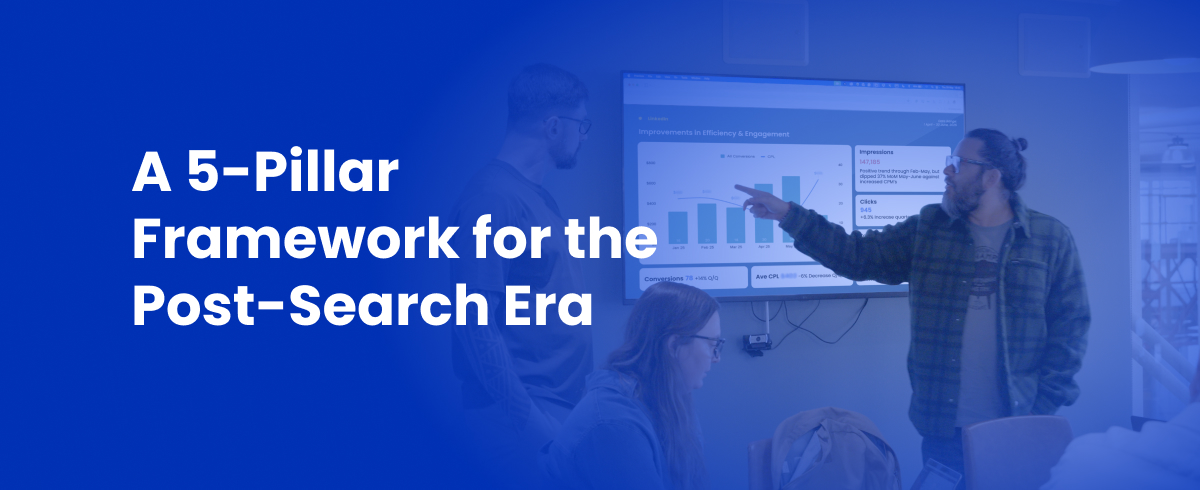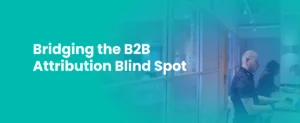A 5-Pillar Framework for the Post-Search Era
The digital marketing landscape has undergone a seismic shift. Traditional SEO strategies, built around ranking for keywords and driving clicks, are becoming less relevant as AI-powered search experiences fundamentally change how users discover and consume information. With nearly 60% of searches now ending without a click and AI Overviews appearing for a growing number of queries, businesses face an uncomfortable truth: visibility no longer guarantees traffic, and traffic no longer guarantees authority.
This challenge has prompted Somebody Digital to spend 18 months deconstructing and rebuilding its approach to organic search. The result is what they call the “Authority Engine”: a comprehensive framework designed not just to survive the AI revolution, but to thrive within it.
“We asked ourselves: If we started with SEO today, what would it look like?” explains Cristiano Winckler, Director of Operations at Somebody Digital, who will be presenting these findings at Brighton SEO San Diego and Brighton SEO UK in October. “It took us 18 months of research, experiments, and rebuilding to create an SEO model built for the answers era. This isn’t SEO 2.0. It’s a completely different operating system.”
The Fundamental Shift: From Keywords to Context
The team’s research revealed three critical shifts reshaping the search landscape. First, authority now trumps visibility. Where traditional SEO focused on ranking highly for specific terms, AI search systems evaluate who would be most trustworthy to answer a user’s query.
“Traditional SEO was a bun fight for visibility,” says Winckler. “AI search is the judge of authority. Who would you trust with the keys to your business? The old world was: Rank, then Click, then Convert. New world is: Authority, then AI Citation, then Revenue.”
Second, context has replaced keywords as the primary ranking factor. “AI doesn’t match words; instead, it maps relationships,” Winckler notes. “It understands when you truly know a topic versus when you’re just stuffing keywords. Context is comprehensive coverage that proves expertise.”
Finally, integration matters more than isolation. AI systems evaluate entire digital footprints across websites, social profiles, industry databases, and media mentions to build trust signals.
The Authority Engine: A Five-Pillar Framework
Somebody Digital’s response to these shifts is their Authority Engine, built on five interconnected pillars that work as an ecosystem rather than sequential steps.
Authority Architecture focuses on systematic expertise extraction. “Your best insights are trapped in conversations,” Winckler explains. “That brilliant engineer with three patents? That product lead who invented your category? They’re invisible online. Interview them. Record everything. Mine those transcripts, that’s where you’ll find the gems.”
The team discovered that the most valuable content often exists in internal discussions, insights that competitors cannot replicate because they emerge from proprietary experience and data.
Context Creation moves beyond individual blog posts to build interconnected content hubs that demonstrate comprehensive knowledge of entire problem spaces. “Stop creating one-off posts,” advises Winckler. “Build interconnected content hubs that show you own entire problem spaces, not just keywords.”
Entity Optimisation goes far beyond basic schema markup. “We all know schema markup isn’t sexy, but tell that to AI,” says Winckler. The approach involves establishing presence in knowledge graphs, Wikipedia entries, and industry databases to become unmistakably findable as a recognised entity.
E-E-A-T Amplification builds verifiable trust signals that AI systems can validate. “AI doesn’t E-E-A-T keywords anymore. Feed it credentials, not crumbs,” Winckler states. These signals include expert speaking engagements, published research, and industry recognition that directly influence where AI models direct attention and revenue.
Integration Strategy ensures all brand touchpoints tell a consistent story. “Think of your brand like an orchestra,” Winckler explains. “Content, PR, SEO, social, they’re all instruments. Integration is the conductor bringing it all together. And AI recognises the music, not the unharmonious noise.”
Practical Implementation: The CTAPS System
To scale this approach without overwhelming internal teams, Somebody Digital developed CTAPS (Call Transcript Analysis System). This three-stage process transforms recorded conversations into authoritative content assets through precision prompt engineering.
“We have produced 67 pages of precise prompts across the three stages,” reveals Winckler. “It took us two months to get it right. Why? Because most people use two-paragraph prompts and wonder why AI produces garbage. This is what proper prompt engineering looks like.”
Each insight is scored for value, timeliness, strategic fit, and evidence hooks, ensuring only credible and unique content makes it through the filtering process.
Proven Results
The framework’s effectiveness is demonstrated through measurable outcomes. One client increased their LLM-driven clicks from 280 to over 1,000 within months. More significantly, organic traffic converted at 0.8%, whilst LLM-referred traffic converted at 16%, a twenty-fold improvement.
“When AI sends someone to you, they’re already pre-qualified. They trust you,” notes Winckler. “Think about what happens if your discovery calls or free trials convert 20× better. Forget impressions, that’s more revenue, faster sales cycles, higher ROI on the same spend.”
The Stakes
The shift represents both challenge and opportunity. “The rules have changed,” concludes Winckler. “Someone here is going to dominate your industry’s AI narrative. The only question left is: will AI see you as the answer, or not at all?”
Winckler will present the complete framework, including technical implementations and measurement strategies, at Brighton SEO UK, delivering actionable insights for businesses ready to transform their organic search strategy for the AI era.




